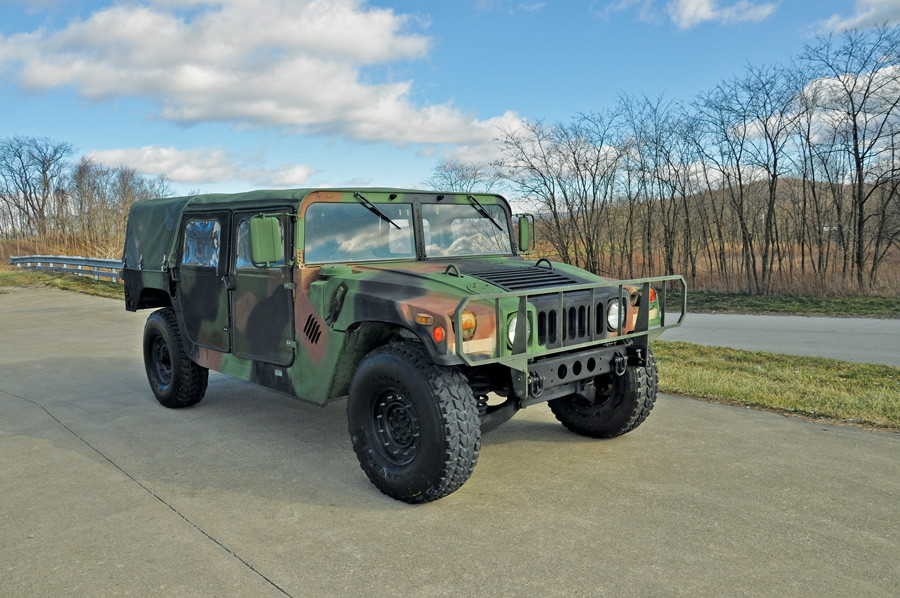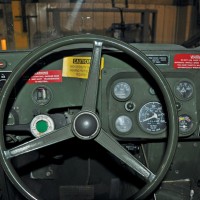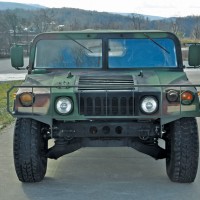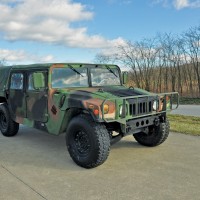From the Ground Force Collection, this 1991 authentic military M998 Humvee/M998 Humvee cargo/troop carrier is built for almost every terrain imaginable and gets to its final destination. It has automatic transmission, a strong 6.2-liter diesel engine, a removable cargo cover, and was upgraded throughout its military life. Due to U.S. military rules, this vehicle cannot be exported and must be purchased by a U.S. citizen.
SCM Analysis
Detailing
| Vehicle: | 1991 AM General Humvee M998 utility |
| Years Produced: | 1983–present |
| Number Produced: | 300,000-plus (260,000 for the U.S. Army, 44,000 for the U.S. Marine Corps) |
| SCM Valuation: | Median to date, $33,000; high sale, $77,000 |
| Chassis Number Location: | Riveted to the outboard driver’s seat stanchion, frame stamped near steering box |
| Club Info: | Military Vehicle Preservation Association |
| Website: | http://www.mvpa.org |
| Alternatives: | 1983–86 Chevrolet M1008 K-30 pickup CUCV series; 1953–83 M151, M151A1, M151A2 MUTT; 1971-85 Steyr Pinzgauer |
| Investment Grade: | C |
This vehicle, Lot 57, sold for $22,000, including buyer’s premium, at Barrett-Jackson’s auction in West Palm Beach, FL, on April 8, 2016.
During the late 1970s, post-Vietnam evaluation of what worked — and what didn’t — the U.S. military sought to replace all quarter-ton through 1¼-ton tactical vehicles with a single platform.
In particular, the M151 quarter-ton MUTT jeeps (which had rollover issues) and the M561 1¼-ton articulated Gama Goat had to go.
The economical stopgap in 1977 was the adoption of the M880 series of trucks based on the Dodge W-200 three-quarter-ton four-wheel-drive pickup. This was a step in the right direction, but it was not entirely what the military had in mind.
In 1979, the Army outlined what it really wanted, which started the High Mobility Multi-purpose Wheeled Vehicle (HMMWV) program. High on the Army’s wish list were extreme off-road maneuverability, large payload, greater survivability in a combat environment, use of readily available commercial components, and diesel power.
Three companies competed for the contract: Chrysler Defense, Teledyne and AMC’s AM General division. It became obvious that AM General had this vehicle dialed in. Their version of the HMMWV (which in short order was nicknamed “Humvee” by the troops and then copyrighted by AM General) got a developmental contract in 1981, with the first production contract in March 1983 for 2,334 units. With aluminum bodywork that was easily configurable, the basic truck was a M998, while units with a front-mounted winch became a M1038.
The first of the Humvees arrived shortly before the end of my stint in the Air Force. Granted, I mostly drove Commercial Utility Cargo Vehicles (CUCVs); military versions of the 1984–86 Chevrolet K-30 pickup and Blazer built as a stopgap before Humvees were fully integrated. Given the choice, I’d take a CUCV over a Humvee any day of the week.
Sure, I can see the benefits of standardization, and you really had to try hard to get a Humvee stuck. However, since I experienced Humvees as overly complex to maintain — along with having poor visibility and being loud, hot and fatiguing to drive — you won’t have to worry about me bidding against you for one. Yet I still understand the fascination for them by vets and civilians alike.
No military Humvees for years
While the Humvee was constantly upgraded and new variations were put into service during the past two decades, there will be no more new U.S. military production. AM General lost out to Oshkosh for the Humvee’s replacement platform in 2015.
Civilian interest in real mil-spec Humvees has not diminished since Desert Storm in 1991, especially as the rugged vehicles were constantly on the news during the wars in Iraq and Afghanistan.
Prior to 2014, the U.S. Department of Defense barred the Humvee from civilian sales.
Telling the American public they can’t have something just makes them want it even more. A few managed to escape the U.S. military’s grasp before 2014, mostly through companies that had contracts for Humvee components. Other Humvees filtered out through state and local agencies that got hand-me-downs from the U.S. military. Those few Humvees saw sky-high pricing in the area of $45k and up for running examples that carried titles.
U.S. military procedure for condemned Humvees was destructive disassembly, selling the pieces as scrap through contract auctions. The level of disassembly tended to vary, but it ranged from shredding whole trucks to just separating bare frames from bare bodies.
Spending $20k to $30k would get you enough parts to create a runner. Titling the rig usually meant claiming it was the 1986 Chevy Suburban that provided the engine and transmission.
Once-forbidden fruit now easy pickings
Even two years ago, the selling price of our featured example would’ve been a smoking-hot deal for a real, unmolested military Humvee, as so few were in circulation. However, the landscape has changed.
A new vendor, Iron Planet, won the contract for selling surplus U.S. military vehicles in 2014. Upon winning the contract, they created a new subsidiary called GovPlanet.com and reached out to their customer base, including the historic military vehicle community, to see how to best serve everyone.
One of the hot topics that refused to die was purchasing surplus Humvees. Iron Planet approached the U.S. military about it. After discussions among various government agencies, it was decided to sell to the public Humvees that were deemed unworthy to refurbish.
None of the Humvees are sold with armor, weapons mounts or titles. In addition, buyers have to sign a “Waiver and Hold Harmless” agreement — and get an End-Use Certificate.
The waiver agreement is a “I bought it knowing what I got myself into” document. The End-Use Certificate is required because Humvees are a “Commercially Controlled” dedicated military design, so the sale has to be to a U.S. citizen, and per the State and Commerce Departments, they are illegal to export.
The first of the online-only auctions took place in December 2014, with prices in the usual $20k to $40k range. However, as more have come on the market (sales are conducted on a weekly basis), prices have steadily fallen. Also affecting the market is that now buyers can apply for an SF97 — the government document used to apply for a title. However, as it’s designated for off-road-use, your state may or may not honor it.
Currently, non-running examples have opening bids at $5,000.
Current market awash with Humvees
During one recent auction, several Humvees didn’t get opening bids, and even more garnered only one to three bids.
Non-runners that sold range from rigs with major components removed (no engine and/or transmission) to having all the reservoir plugs removed to drain all the fluids and then tossing all of the plugs into the cab. As such, you may have a parts truck — or you may have a nice runner with $100 worth of fluids and one evening of work. On the other hand, some Humvees are a glow-plug wait away from hitting the trail.
Occasionally a few Humvees surface on GovPlanet that don’t come directly from the military. Like earlier escapees, they may be other federal, state, or local agencies that had Humvees transferred to them over the years.
Almost all of these Humvees do include a state-issued title, and those trucks command a premium, with starting bids in the $14k to $15k region — and selling prices close to our featured rig.
Our featured Humvee was presented as turn-key ready with a title. As such, a collection that is knowledgeable about the mechanical and legal challenges of military vehicles already did the heavy lifting, so it was just a case of bid and buy. That has a great deal of value — well above just the raw truck.
Yet in a few months, with more and more Humvees entering the market (and some folks finding out that it’s not their bag of MREs), values are on track to continue settling downwards at a steady rate. This was a decent buy on the day it was bought, but now our featured truck is a market-correct sale. ♦
(Introductory description courtesy of Barrett-Jackson.)



